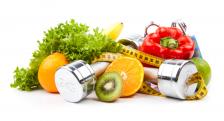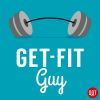What to Eat Before and After Exercising
Get tips on exactly what to eat before, during, and after exercising for better workouts.
Listen
What to Eat Before and After Exercising

How often do you think about exactly what you’re going to eat before you exercise? How about what you’re going to eat when you’re done exercising? And no, I’m not talking about that big bowl of ice cream or tasty martini that you’re trying to earn while you’re slaving away on the treadmill. I’m talking about really planning your pre and post-workout fueling so that you get maximum results from your fitness efforts.
What to Eat Before and After Exercising
If you don’t have a nutrition plan for your fitness routine, you’re doing yourself a pretty big disservice when it comes to getting the results that you desire. If you workout while you’re starved, you simply won’t have the energy for your body to gain maximum fitness. If you exercise for a long time without eating, you’ll limit your ability to burn calories and maintain intensity. And if you don’t feed your muscles and replenish your energy stores after exercise, you won’t have the necessary building blocks for recovery.
In this article, you’re going to learn about ideal pre-workout, during workout, and post-workout nutrition, with a quick and dirty tip for optimizing each of these components of fitness fueling.
What Should You Eat Before Exercising?
Just before you exercise, the last thing you want to do is put a bunch of proteins and fats into your body, even if they’re healthy proteins and fats. These types of fuels take a long time to digest and draw precious oxygen and energy-delivering blood into your stomach and away from your exercising muscles. They also carry a greater risk of giving you a stomachache during your exercise. But if you don’t eat at all, you risk breaking down muscle and causing a great deal of stress to your body during exercise.
The ideal pre-workout meal is consumed about two hours before exercise, contains about 300-500 calories, and is composed primarily of healthy carbohydrates. If you don’t have time to eat two hours before, a quick 50-100 calorie snack 5-10 minutes prior to exercise will also be effective.
Good Pre-Exercise Snacks
Try a bowl of oatmeal, whole-grain cereal, whole-wheat toast, or even sweet potato or yam as a pre-workout meal eaten two hours before your workout. If you have to eat directly before your workout, a small piece of fruit—like an apple or banana—will do. If that sounds a bit too blah for you, then you can try just a little bit of protein or fat, like a teaspoon of peanut butter or a small handful of almonds, but just don’t go overboard and eat last night’s pizza for your pre-workout meal.
What Should You Eat While Exercising?
Interestingly, research has shown that if you exercise for longer than 60 minutes without supplying your body with any nutrients, you actually burn few calories and less fat than if you had eaten, and your post exercise metabolic rate, or rate of calorie burning, is also lower.
If you plan on exercising for less than an hour, you don’t need to eat; just make sure you hydrate with small, frequent sips of water during your workout. But if you’re doing something like a long run or bike ride, or maybe a couple of back-to-back fitness classes, try to eat 50-100 calories every half hour, preferably from a quick carbohydrate source that is easy to carry, like a ziplock bag of raisins, an energy bar, energy gels, or even a sports drink. The goal is not to replace every calorie that you burn, but rather to give you just enough fuel so that you can maintain a brightly burning metabolism. And one other quick and dirty tip: Make sure you review your health club’s rules about eating in the gym; the last thing you want is a personal trainer chiding you for your trail of animal crackers.
What Should You Eat After a Workout?
There is a window of time about 20-60 minutes after you exercise in which your muscles will readily accept the carbohydrates and protein that you consume and suck them up to be stored away as precious energy and building blocks for recovery. But if you wait too long after exercising to eat, your body become less likely to use what you eat as fuel and recovery, and more likely to run out of energy during your next exercise session, whether later in the day or even the next day.
The ideal post-workout meal is comprised of a blend of carbohydrates and protein. There are all sorts of fancy ratios used by elite athletes, but the basic rule is to eat just a little more carbohydrates than protein, and to consume about 2 calories of carbohydrate for every pound of target bodyweight. For example, if your target bodyweight is 150lbs, you should eat about 300 calories of carbohydrate, and about half that many calories of protein. A sample post-workout meal would be chicken with brown rice, yogurt with almonds, or a protein shake with a banana.
Here’s your quick and dirty tip for post-workout fueling: Don’t wait until you get home or to your office to eat. Typically, by the time you’ve prepared breakfast, lunch, or dinner, you’ve missed your magic window of 20-60 minutes. Instead, prepare and carry your post-workout fuel in your gym bag or car. This is when Ziplocs, Tupperware containers, and shaker cups will be quite handy.
Summary
As you can see, when it comes to getting fit, nutrition is just as big a part of the equation as exercise. That doesn’t mean you need to arrive at the gym with a grocery shopping bag full of fruit, or a 24-pack of energy drinks, but it does mean that you should plan ahead to give your body the fuel it needs for fitness. Don’t worry–you aren’t going to sabotage your fat-loss efforts as long as you fuel in moderation. The way I like to think about it is this: Take good care of your body’s fueling needs for exercise, and engage in any type of caloric restriction apart from exercise.
Related tip:
Should You Eat Carbs After a Workout?
Food and Exercise Equipment image from Shutterstock

